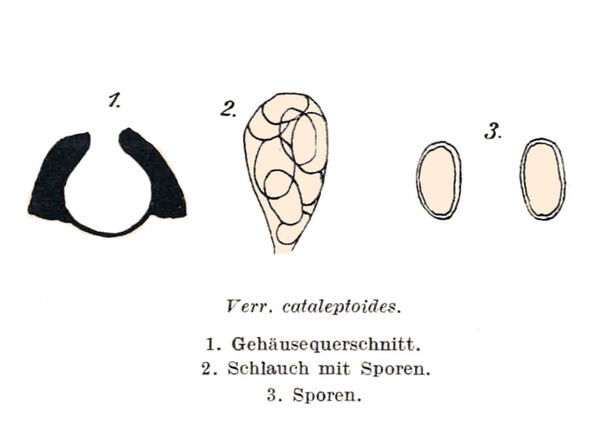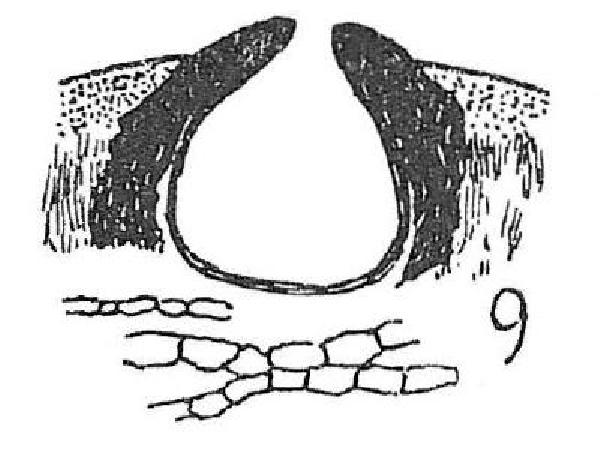Verrucaria cataleptoides (Nyl.) Nyl.
Bull. Soc. Bot. Fr., 10: 268, 1861. Basionym: Verrucaria margacea var. cataleptoides Nyl. - Act. Soc. linn. Bordeaux, 21: 428, 1856.
Synonyms: Verrucaria aethiobola var. cataleptoides (Nyl.) Vain.,
Description: Thallus crustose, episubstratic, pale grey-brown to pale brown, 0.15-0.23(-0.3) mm thick, not gelatinous when wet, irregularly cracked-areolate, delimited by a discontinuous, black prothallus, the fertile areoles 3-4 times taller and wider than the sterile ones. Cortex 20-30 μm thick; algal layer c. 100 μm thick, continuous, the cells arranged in more or less distinct columns; medulla whitish, c. 100 μm thick, paraplectenchymatous, in lower part often patchily brownish, especially around the perithecia. Perithecia black, immersed in the centre of areoles, 1(-3) per areole. Involucrellum adpressed and completely surrounding the exciple, 50-70(-80) μm thick; exciple 0.2-0.25 μm across, the wall dark brown throughout; hamathecium of up to 40 μm long periphyses and periphysoids, interascal filaments absent. Asci 8-spored, clavate, I-, fissitunicate, the wall thickened above, with an ocular chamber, dehiscent by extrusion of an endotunica to form a delicate rostrum, Verrucaria-type. Ascospores 1-celled, hyaline, ellipsoid, 23-25 x 8-10(-12) μm. Pycnidia black, completely immersed in thallus, 100-150 μm across. Conidia oblong, 6-8 μm long. Photobiont chlorococcoid. Spot tests: K-, C-, KC-, P-, UV-. Chemistry: without lichen substances.
Growth form: Crustose
Substrata: rocks
Photobiont: green algae other than Trentepohlia
Reproductive strategy: mainly sexual
Poorly known taxon in need of further study
Commonnes-rarity: (info)
Alpine belt: absent
Subalpine belt: extremely rare
Montane belt: extremely rare
Dry submediterranean belt: extremely rare
Humid submediterranean belt: absent
Padanian area: absent
pH of the substrata:
1 2 3 4 5
Solar irradiation:
1 2 3 4 5
Aridity:
1 2 3 4 5
Eutrophication:
1 2 3 4 5
Poleotolerance:
0 1 2 3
Altitudinal distribution:
1 2 3 4 5 6
Rarity
absent
extremely rare
very rare
rare
rather rare
rather common
common
very common
extremely common
Loading data...
Occurrence data
Predictive map
Growth form: Crustose
Substrata: rocks
Photobiont: green algae other than Trentepohlia
Reproductive strategy: mainly sexual
Poorly known taxon in need of further study
Commonnes-rarity: (info)
Alpine belt: absent
Subalpine belt: extremely rare
Montane belt: extremely rare
Dry submediterranean belt: extremely rare
Humid submediterranean belt: absent
Padanian area: absent
pH of the substrata:
| 1 | 2 | 3 | 4 | 5 |
Solar irradiation:
| 1 | 2 | 3 | 4 | 5 |
Aridity:
| 1 | 2 | 3 | 4 | 5 |
Eutrophication:
| 1 | 2 | 3 | 4 | 5 |
Poleotolerance:
| 0 | 1 | 2 | 3 |
Altitudinal distribution:
| 1 | 2 | 3 | 4 | 5 | 6 |
Rarity
absent
extremely rare
very rare
rare
rather rare
rather common
common
very common
extremely common
Loading data...
Occurrence data
Predictive map








